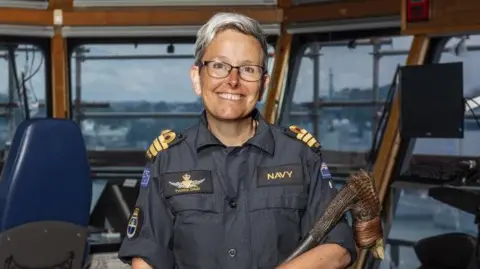New Zealand minister criticises trolling of sunk ship’s female captain
New Zealand’s defence minister has criticised “armchair admirals” for suggesting that a female captain’s gender was to blame for the sinking of one of the nation’s naval ships.
HMNZS Manawanui ran aground one nautical mile from the Samoan island of Upolu on Saturday night while surveying a reef. It later caught fire and capsized.
All 75 people on board were evacuated onto lifeboats and rescued early on Sunday, New Zealand’s Defence Force said in a statement.
Officials are now investigating the cause of the incident and assessing the wreck’s potential environmental damage.
“A court of inquiry has been stood up to establish what caused this terrible incident,” said Judith Collins, New Zealand’s first female defence minister.
“The one thing that we already know did not cause it is the gender of the ship’s captain.”
British-born Commander Yvonne Gray, who previously served in the UK’s Royal Navy, was the captain of HMNZS Manawanui.
She told the New Zealand Herald the incident saw her “very worst imagining” become a reality.
But Cdr Gray added that the crew had responded to the emergency “exactly the way I needed them to” and “acted with commitment, with comradeship and, above all, with courage”.
Collins said she was appalled to see online trolling from “armchair admirals, people who will never have to make decisions which mean life or death for their subordinates”.
She added: “I thought seriously in 2024 what the hell is going on here with people who are sitting there in their armchair operating a keyboard making comments about people that they do not know, about an area they do not know and they are just vile. Where’s a bit of decency.”
 New Zealand Defence Force
New Zealand Defence ForceCollins said that women in uniform had been abused in the street in recent days.
“This is outrageous behaviour and New Zealand is not known for this and we are better than it.”
HMNZS Manawanui is the first ship New Zealand’s Navy has lost to the sea since World War Two.
Collins previously indicated that it had been in an area that had not been surveyed since 1987.
On Thursday morning, Samoa’s Marine Pollution Advisory Committee (MPAC) said the ship was “leaking oil from three separate locations”, but that there continues to be “no trace” of oil washing up onshore.
Samoan officials said it was believed that most of the ship’s fuel had burnt off during the fire onboard, and that oil in the sea had been observed dissipating quickly.
But some have expressed concern about the possible environmental effects.
Local resident Manu Percival told Radio NZ on Monday that he had seen oil along the coastline.
“There’s so many green sea turtles in that area, so many sting rays,” he said.
“Right where the ship went down just inland, there’s a huge lagoon of brackish water and it houses all sort of animals. Coconut crabs, everything. They’ll all be affected.”
New Zealand’s Defence Force said a navy team had been established “to react to any contamination of local beaches and to remove debris that has started to come ashore”.
It added that divers from the Samoan Ministry of Resources and Natural Environment had also “observed damage to the reef where the collision occurred”.
Military officials in New Zealand have said the inquiry into the sinking will investigate the sequence of events leading up to it, as well as the cause of the grounding and sinking.
New Zealand has a long history of gender equality and was the first country to grant women the right to vote.
But the nation’s most recent female prime minister, Jacinda Ardern, received frequent misogynistic abuse while in office – a topic often debated in the country’s media.
About 20% of New Zealand’s uniformed defence force personnel are women.



